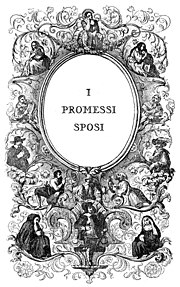The Betrothed (Manzoni novel)
Template:NovelsWikiProject Collaboration
 Title page of the edition of 1840. | |
| Author | Alessandro Manzoni |
|---|---|
| Original title | I Promessi Sposi |
| Country | Italy |
| Language | Italian |
| Genre | Literature |
| Publisher | Penguin Classics |
Publication date | 1984 (1842) |
| Media type | Print (Paperback) |
| Pages | 720 pp |
| ISBN | ISBN 0-14-044274-X Parameter error in {{ISBNT}}: invalid character |
I Promessi Sposi (English: The Betrothed) is an Italian historical novel by Alessandro Manzoni. It is the most famous and widely read novel of the Italian language.[citation needed]
Based in northern Italy in the early 17th century, during the terrible, oppressive years under Spanish rule, it is really a veiled attack on Austria, who controlled the region at the time of writing (the definitive version was published in 1842). It is also noted for the extraordinary description of the plague that struck Milan in 1630.
Far from being merely a work of historical fiction though (as an historical novel, The Betrothed was inspired by Walter Scott's Ivanhoe and was the first Italian historical novel), the novel deals with a variety of themes, from the cowardly, hypocritical nature of a priest (Don Abbondio) and the heroic sainthood of others (Padre Cristoforo, Federico Borromeo), to the unwavering strength of love (the relationship between Renzo and Lucia and the struggle of these betrothed to finally meet again and get married), and offers some keen insights into the meanderings of the human mind.
The protagonist of the novel is the Divine Providence. At the end of the book, it said: "After a long debating and searching together, they concluded that troubles often come, yes, because we've given us a cause; but that the most cautious and innocent conduct isn't enough to keep them away; and that when they come, with guilt or without guilt, the trust in God sweetens them, and makes them useful for a better life. This conclusion, although found by poor people, has seemed us so just, that we have thought to put it there, as the juice of all the story. [...]"
Although widely under-appreciated abroad, in Italy the novel is considered a real masterpiece of world literature and the basis for modern Italian, and as such widely read and studied in every school.
Many expressions, quotes and names from the novel are still commonly used in Italian, such Perpetua or Questo matrimonio non s'ha da fare ("This marriage is not to be performed", used ironically).
I promessi sposi was made into an opera of the same name by Amilcare Ponchielli in 1856 and by Errico Petrella in 1869. There have been many film versions of I promessi sposi: 1909, 1913, 1923, 1941, 1964, etc.
Characters
- Renzo Tramaglino is a young man of humble origins engaged to Lucia, whom he loves deeply. Initially rather naive, he becomes more cunning throughout the novel as he is confronted with many difficulties: he is separated from Lucia and then unjustly accused of being a criminal. Renzo is somewhat short-tempered, but also gentle and honest.
- Lucia Mondella is a pious and kind young woman who loves Renzo. She is forced to flee from her town to escape from Don Rodrigo (in one of the most famous scenes of Italian literature, the Addio ai Monti ("Farewell to the mountains").
- Don Abbondio is the priest who refuses to marry Renzo and Lucia because he has been threatened by don Rodrigo's men; he also meets the two protagonists several times during the novel. The cowardly, morally mediocre don Abbondio provides most of the book's comic relief; however, he is not merely a stock character, as his moral failings are portrayed by Manzoni with a mixture of irony, sadness and pity, as has been noted by Luigi Pirandello in his essay "On Humour" ("Saggio sull'Umorismo").
- Fra Cristoforo is a brave and generous friar who helps Renzo and Lucia, acting as a sort of "father figure" to both and as the moral compass of the novel.Fra Cristoforo was the son of a wealthy family that joined the Capuchin Order after killing a man.
- Don Rodrigo is a cruel and despicable nobleman and the novel's main villain. He decides to prevent with the force Renzo and Lucia's marriage, threatens to kill Don Abbondio if he marries the two and tries to kidnap Lucia.
- L'Innominato (literally: the Unnamed) is probably the novel's most complex character, a powerful and feared criminal who is torn between his ferocious past and the increasing disgust he feels for his life. Based on a historical character.
- Agnese is Lucia's wise mother.
- Federico Borromeo is a virtuous and zealous cardinal. Historical character.
- Perpetua is Don Abbondio's loquacious servant.
- La Monaca di Monza (the Nun of Monza) is a tragic figure, a bitter, frustrated and ambiguous woman. She befriends Lucia and becomes genuinely fond of her, but her dark past still haunts her. Based on a historical character.
- Griso is one of Don Rodrigo's henchmen, a silent and traitorous man.
- Azzecca-garbugli is a corrupt lawyer.
- Count Attilio is Don Rodrigo's malevolent cousin.
- Nibbio (Kite - the bird) is the Innominato's right-hand man.
- Don Ferrante is a phoney intellectual and erudite scholar who believes the plague is caused by astrological forces.
- Donna Prassede is Don Ferrante's wife, who is willing to help Lucia but is also a slightly arrogant bigot.
External links
- English translation of 'The Betrothed'
- A review of "The Betrothed" written by E.A. Poe in 1835 and published in "The Southern Literary Messenger".
- Audiobook Complete Reading - MP3 Creative Commons
